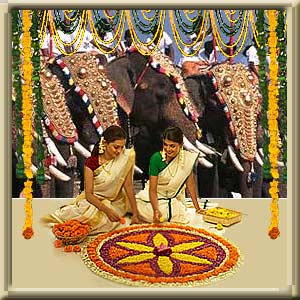 |
malayalee wedding, kerala wedding
Simplicity and brevity mark a typical Malayalee Nair wedding. Lasting barely a few minutes, a Kerala wedding is one with little rituals and far lesser religious compulsions. The Malayalee month Chingam is considered to be the most auspicious month to conduct malayalee weddings. The months of Midhunam, Karkatakam and Kanni are generally avoided. However, even during the inauspicious months, malayalee weddings do take place in Guruvayoor temple, the abode of Lord Guuvayurappan.
Pre wedding ceremonies
Muhurtham: The parents of the girl and boy exchange horoscopes to check for compatibility. If the horoscopes match, an auspicious date or muhurtham, the date for conducting the wedding ceremony is fixed in consultation with the family astrologer.
Nischayam or the engagement ceremony: Is purely to announce, share and celebrate the joyful event of confirmation of marriage. Traditional families do not encourage the presence of boy and girl during the nischayam ceremony. Gifts are exchanged between the families. The bride's parents gift gold or diamond ring, suits to the bridegroom while the bridegroom's parents gift the bride gold ornaments like chain, necklace, rings, salwars, silk saris, accessories etc. The guests are treated to traditional vegetarian or non-vegetarian malayalee dishes.
Traditional feast: Friends and relatives arrive from outstation cities and villages arrive a day earlier to participate in the customary dinner served at the bride's residence. The bride is dressed in fine jewelry, silk sari and is made to sit facing east direction. She is asked to partake a five-course vegetarian meal along with her family
Wedding rituals
The most preferred destination to conduct malayalee weddings is the ancestral house of the bride. These days it is common to select a common venue that is convenient and suitable for both the families.
Friends of bride help her in dressing up for the big occasion. She is embellished with flowers, clad in the traditional two-piece sari known as Mundu and a line of gold necklaces adorn her neck, gold bangles in exquisite designs fill her hands, gold rings studded with precious stones adorn her fingers, a silver or gold payal or anklets, arm bands are all part of the bridal jewelry.
The bridegroom is dressed up in traditional dhoti and angavastram. Gold chain, gold bracelets and rings complete his attire. Elders and close friends accompany the bridegroom to the bride's place.
Madhuparkam: As part of the ritual, the bride's brother welcomes the bridegroom and honors him by washing his feet as he arrives at the venue. The groom in turn hands over to his father-in-law an off white color sari that has to be worn by the bride for the nuptials. Young girls carry 'deepams' in their hand and lead the couple to the mantap.
Veli or nuptial ceremony: The family priest or patriarch performs the wedding rituals. The couple walks around thrice after which the groom ties the 'mangalsutra' or 'tali' around the neck of the bride. They exchange garlands. People present at the venue shower flowers and bless the couple. Friends and relatives extend their best wishes and present gifts.
Immediately thereafter, the kanyadaanam or penkoda ceremony takes place. The bride's father gives her hand and places it on the groom's hand symbolically transferring her responsibility to the bridegroom. A typical meal in Kerala known as sadya, which consists of 25 items, is served on plantain leaves. Rice, three varieties of pickle, curries and sweets, Avial, toran, olan, kalam, pacchari, payasam, pappads and finally the desert paladaaprathaman or chaka prathaman, form part of the elaborate meal.
Post wedding ceremony
Grihapravesh: At an appointed auspicious time, the bride proceeds to her new home. She takes the blessings of her parents and all elders present at the venue. As she reaches her new house, the women take 'aarthi' to cast off evil eye. The bride holds a traditional lamp in her hand and is asked to enter the house with her right foot. The entire house is bright with lamps lit all over the house, considered to be a good omen as the couple starts their life together. This ceremony is called 'kudivep'. The in-laws give the bride jewels and gifts
|

















